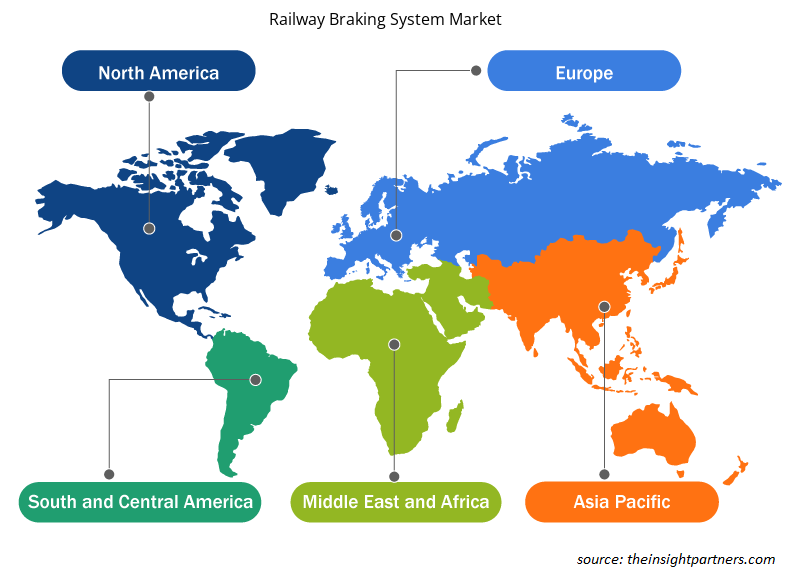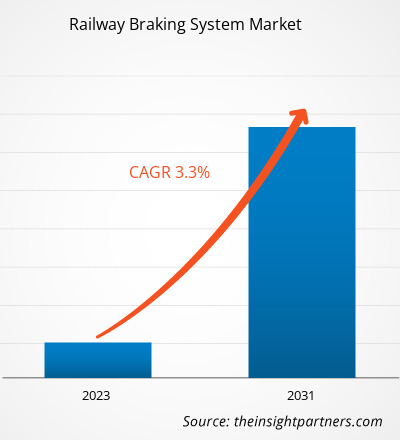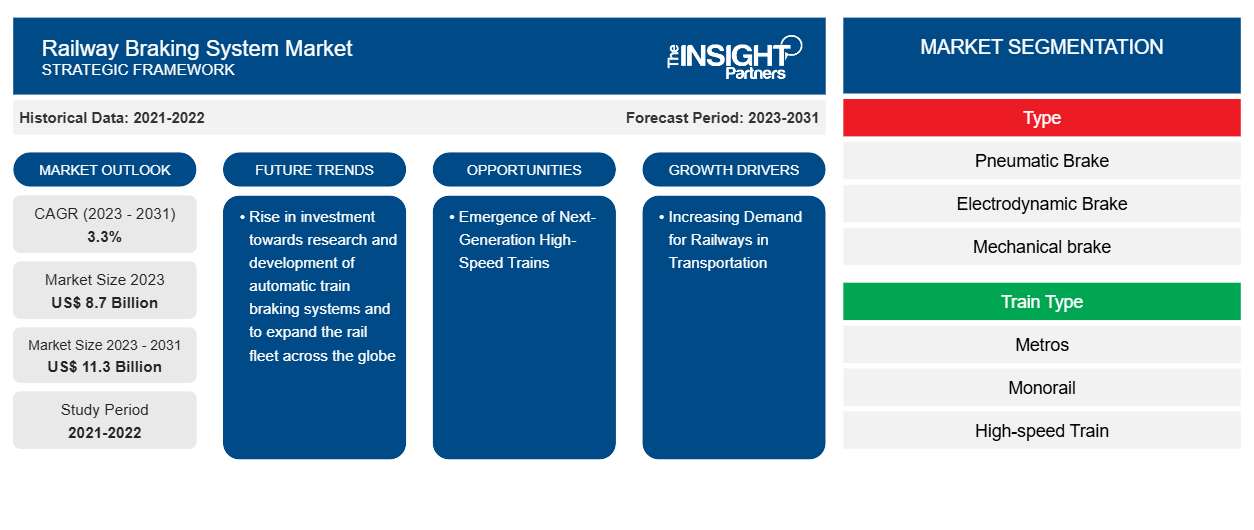Der Markt für Eisenbahnbremssysteme soll von 8,7 Milliarden US-Dollar im Jahr 2023 auf 11,3 Milliarden US-Dollar im Jahr 2031 anwachsen. Der Markt soll zwischen 2023 und 2031 eine durchschnittliche jährliche Wachstumsrate von 3,3 % verzeichnen. Zu den wichtigsten Trends, die den Markt für Eisenbahnbremssysteme antreiben, zählen steigende Investitionen in die Forschung und Entwicklung automatischer Zugbremssysteme und die Erweiterung der weltweiten Schienenfahrzeugflotte.
Marktanalyse für Eisenbahnbremssysteme
Faktoren wie die steigende Nachfrage der Privatpersonen nach Schienenverkehr als Transportmittel und wachsende Bahnprojekte zum Bau neuer Schienen und Linien für U-Bahn, Einschienenbahn und Hochgeschwindigkeitszüge. Projekte in Verbindung mit steigenden staatlichen Investitionen zum Ausbau des Eisenbahnsektors tragen weiterhin zur Stärkung des Eisenbahnsektors bei. Mit dem Wachstum des Eisenbahnsektors gewinnt die Integration von Sicherheitssystemen, darunter Bremsen, stark an Dynamik. Darüber hinaus ist die Einführung automatischer Zugbremssysteme, des automatischen Zugbetriebs und von Hochgeschwindigkeitszügen der nächsten Generation in Schwellenländern ein weiterer Faktor, der das Marktwachstum für Bremssysteme antreibt. Außerdem wirkt sich die steigende Zahl von Volumenpaketen und des Handels in den Ländern auf die Nutzung der Eisenbahn aus, da sie im Vergleich zum Luftweg das günstigste Transportmittel ist. Daher hat sich mit dem florierenden Güterverkehr auch der Entwicklungszyklus des Güterverkehrs auf der Schiene erhöht. Mit der zunehmenden Entwicklung von Stadtbahnen wird auch die Integration von Bremssystemen zunehmen.
Marktübersicht für Eisenbahnbremssysteme
Angesichts wichtiger Megatrends wie Nachhaltigkeit, Urbanisierung, Mobilitätsfahrzeuge und Digitalisierung erlebt die Transportbranche ein enormes Wachstum. Die oben genannten Trends werden dem Eisenbahnsektor zugutekommen, indem sie langfristige, nachhaltige Wachstumschancen für die Mobilität der Zukunft bieten. Darüber hinaus werden aufgrund der strengen Sicherheits- und Qualitätsstandards im Eisenbahnsektor zunehmend fortschrittliche Systeme und Ausrüstungen integriert. Im Eisenbahnsektor gehören Gleise mit doppelter elastischer Befestigung, automatisiertes Fahren , Oberleitungen/Stromschienen und kommunikationsbasierte Zugsteuerungs- und Signalsysteme zu den wenigen Technologien, die in U-Bahn-Linien integriert werden. Die Integration dieser fortschrittlichen Technologien in die U-Bahn-Schienen wird eine wesentliche Rolle bei der Erweiterung des Spielraums für die Integration von Schienenbremssystemen spielen.
Passen Sie diesen Bericht Ihren Anforderungen an
Sie erhalten kostenlos individuelle Anpassungen an jedem Bericht, einschließlich Teilen dieses Berichts oder einer Analyse auf Länderebene, eines Excel-Datenpakets sowie tolle Angebote und Rabatte für Start-ups und Universitäten.
-
Holen Sie sich die wichtigsten Markttrends aus diesem Bericht.Dieses KOSTENLOSE Beispiel umfasst eine Datenanalyse von Markttrends bis hin zu Schätzungen und Prognosen.
Treiber und Chancen auf dem Markt für Eisenbahnbremssysteme
Steigende Nachfrage nach Schienenverkehr im Transportwesen
Der Schienenverkehr gilt im Vergleich zum Straßenverkehr allgemein als sicheres, zuverlässiges und wirtschaftliches Transportmittel. Aufgrund von Faktoren wie hoher Präzision und der Fähigkeit, ein möglichst großes geografisches Gebiet abzudecken, steigt die Nachfrage der Reisenden. Um die Sicherheit von Zügen, Fracht und Passagieren zu gewährleisten, werden in Schienen unter anderem Bremssysteme eingesetzt. Darüber hinaus tragen Regierungsprojekte wie die Dubai Route 2020 Metro zum Bau neuer Schieneninfrastruktur und steigende Investitionen zur Erweiterung der Zugverbindungen zum Wachstum des Schienenverkehrssektors bei. Auch die Nachfrage nach Schienen für den Güterverkehr steigt. Mit dem zunehmenden Volumen an Paketen und Gütern, die über die Schiene transportiert werden, steigt die Zahl der Züge. Der massive Gütertransport über die Schiene schafft lukrative Möglichkeiten sowohl für Zug- als auch für andere bahnbezogene Systemhersteller. Dieser Aspekt des zunehmenden Güterverkehrs und der Zahl der Bahnpassagiere fördert also das Wachstum des Schienenverkehrssektors und motiviert die Regierungen der Länder, massiv in Schienenprojekte zu investieren.
Entstehung von Hochgeschwindigkeitszügen der nächsten Generation
In einer Zeit ständiger technologischer Fortschritte erlebt die Eisenbahnindustrie weltweit neue Technologien und Systeme, die eine entscheidende Rolle bei der Umgestaltung des gesamten Sektors spielen. So stellt Südkorea im April 2024 einen Hochgeschwindigkeitszug der nächsten Generation vor. Dieser Zug hat eine Höchstgeschwindigkeit von 320 km/h. Darüber hinaus stellte Frankreich im Oktober 2023 seine Hochgeschwindigkeitszüge der nächsten Generation TGV M vor, die voraussichtlich 2025 in Betrieb gehen werden. Solche technologischen Fortschritte und die Entstehung von Hochgeschwindigkeitszügen auf der ganzen Welt werden voraussichtlich die Nachfrage nach dem Markt für Eisenbahnbremssysteme im Prognosezeitraum ankurbeln.
Auch die Einführung von Druckluftscheibenbremsen der nächsten Generation trägt zur Transformation der Schienen bei. Außerdem werden die Bremsbefehle beim Direktbremssystem schnell und mit kürzerer Zeitverzögerung übertragen. Darüber hinaus arbeitet Shift2Rail – ein Gemeinschaftsunternehmen – an einer digitalen Bremstestlösung, mit der die Fahrer die Bremsen von ihrer Kabine aus über ein Tablet testen können. Diese digitale Bremstestlösung würde helfen, Zeit und Arbeitskosten zu sparen und gleichzeitig Flexibilität und Sicherheit zu verbessern. Im Zeitalter der Mobilität der nächsten Generation würden das Aufkommen von Hochgeschwindigkeitszügen, digitalen Testbremslösungen und Bremsen der nächsten Generation dazu beitragen, den Eisenbahnsektor für die Zukunft zu rüsten. Alle genannten Aspekte werden voraussichtlich eine wichtige Rolle bei der Einführung von Eisenbahnbremssystemen spielen.
Segmentierungsanalyse des Marktberichts zum Eisenbahnbremssystem
Wichtige Segmente, die zur Ableitung der Marktanalyse für Eisenbahnbremssysteme beigetragen haben, sind Typ und Zugtyp.
- Basierend auf dem Typ wurde der Markt für Eisenbahnbremssysteme in pneumatische Bremsen, elektrodynamische Bremsen, mechanische Bremsen und elektromagnetische Bremsen unterteilt. Das Segment der pneumatischen Bremsen hatte im Jahr 2023 einen größeren Marktanteil.
- Basierend auf dem Zugtyp wurde der Markt für Eisenbahnbremssysteme in U-Bahnen, Einschienenbahnen, Hochgeschwindigkeitszüge, Stadtbahnen/Straßenbahnen und Güterzüge unterteilt. Das Segment der Stadtbahnen/Straßenbahnen hatte im Jahr 2023 einen größeren Marktanteil.
Marktanteilsanalyse für Eisenbahnbremssysteme nach Geografie
Der geografische Umfang des Marktberichts für Eisenbahnbremssysteme ist hauptsächlich in fünf Regionen unterteilt: Nordamerika, Europa, Asien-Pazifik, Naher Osten und Afrika sowie Südamerika.
Der asiatisch-pazifische Raum wird 2023 den Markt für Eisenbahnbremssysteme dominieren. Der asiatisch-pazifische Raum umfasst Australien, China, Japan, Indien, Südkorea und den Rest des asiatisch-pazifischen Raums. Stabile Volkswirtschaften und technologische Fortschritte unterstützen das Wachstum einer vielfältigen Palette von Branchen und Märkten in der Region. Die regionale Eisenbahnnetzanbindung in der Region Südostasien wird durch die Umsetzung mehrerer Projekte zur Verbindung bestehender Strecken im Rahmen des panasiatischen Eisenbahnnetzes besser. Neue, von der chinesischen Regierung unterstützte und geplante Eisenbahnprojekte würden Verbindungen zwischen den großen Städten auf dem südostasiatischen Festland sicherstellen – von Kunming in China bis Bangkok, Singapur und Kuala Lumpur, mit einer zentralen Linie von Vientiane in Laos nach Bangkok; einer östlichen Linie durch Hanoi und Ho-Chi-Minh-Stadt in Vietnam und Phnom Penh in Kambodscha; und einer westlichen Linie durch Yangon in Myanmar.
Indonesien und die Philippinen planen ebenfalls Eisenbahnprojekte, um wichtige Städte mit ihren Hauptinseln zu verbinden. Die Eisenbahnsektoren der Philippinen, Thailands, Chinas und Indiens tätigen enorme Investitionen in ihren jeweiligen Gebieten, um den Schienenverkehr durch die Integration fortschrittlicher Technologien zu stärken. Darüber hinaus gehört Japan zu den großen Ländern, die Hochgeschwindigkeitszüge einsetzen, um die Überlastung der Straßen zu verringern und den Fahrgästen Zeit und Geld zu sparen.
Regionale Einblicke in den Markt für Eisenbahnbremssysteme
Die regionalen Trends und Faktoren, die den Markt für Eisenbahnbremssysteme im Prognosezeitraum beeinflussen, wurden von den Analysten von Insight Partners ausführlich erläutert. In diesem Abschnitt werden auch die Marktsegmente und die Geografie von Eisenbahnbremssystemen in Nordamerika, Europa, im asiatisch-pazifischen Raum, im Nahen Osten und Afrika sowie in Süd- und Mittelamerika erörtert.

- Erhalten Sie regionale Daten zum Markt für Eisenbahnbremssysteme
Umfang des Marktberichts über Eisenbahnbremssysteme
| Berichtsattribut | Details |
|---|---|
| Marktgröße im Jahr 2023 | 8,7 Milliarden US-Dollar |
| Marktgröße bis 2031 | 11,3 Milliarden US-Dollar |
| Globale CAGR (2023 - 2031) | 3,3 % |
| Historische Daten | 2021-2022 |
| Prognosezeitraum | 2023–2031 |
| Abgedeckte Segmente |
Nach Typ
|
| Abgedeckte Regionen und Länder |
Nordamerika
|
| Marktführer und wichtige Unternehmensprofile |
|
Marktteilnehmerdichte: Der Einfluss auf die Geschäftsdynamik
Der Markt für Eisenbahnbremssysteme wächst rasant, angetrieben durch die steigende Nachfrage der Endnutzer aufgrund von Faktoren wie sich entwickelnden Verbraucherpräferenzen, technologischen Fortschritten und einem größeren Bewusstsein für die Vorteile des Produkts. Mit steigender Nachfrage erweitern Unternehmen ihr Angebot, entwickeln Innovationen, um die Bedürfnisse der Verbraucher zu erfüllen, und nutzen neue Trends, was das Marktwachstum weiter ankurbelt.
Die Marktteilnehmerdichte bezieht sich auf die Verteilung von Firmen oder Unternehmen, die in einem bestimmten Markt oder einer bestimmten Branche tätig sind. Sie gibt an, wie viele Wettbewerber (Marktteilnehmer) in einem bestimmten Marktraum im Verhältnis zu seiner Größe oder seinem gesamten Marktwert präsent sind.
Die wichtigsten auf dem Markt für Eisenbahnbremssysteme tätigen Unternehmen sind:
- DAKO-CZ
- Akebono Bremsenindustrie Co., Ltd.
- Amsted-Bahn
- Knorr-Bremse AG
- Nabtesco Corporation
- Sabre Rail Services Ltd
Haftungsausschluss : Die oben aufgeführten Unternehmen sind nicht in einer bestimmten Reihenfolge aufgeführt.

- Überblick über die wichtigsten Akteure auf dem Markt für Eisenbahnbremssysteme
Nachrichten und aktuelle Entwicklungen zum Markt für Eisenbahnbremssysteme
Der Markt für Eisenbahnbremssysteme wird durch die Erhebung qualitativer und quantitativer Daten nach Primär- und Sekundärforschung bewertet, die wichtige Unternehmensveröffentlichungen, Verbandsdaten und Datenbanken umfasst. Im Folgenden finden Sie eine Liste der Entwicklungen auf dem Markt für Eisenbahnbremssysteme und Strategien:
- Im Januar 2024 bestellte die Wabtec Corporation bei Siemens India Private Limited ein Bremssystem im Wert von 157 Millionen US-Dollar. Im Rahmen dieses Liefervertrags wird Siemens Limited Bremssysteme mit verbesserter Betriebsleistung, Effizienz und Sicherheit für die neue Linie von 1.200 Elektrolokomotiven liefern.
- Im Oktober 2023 brachte Siemens Mobility ein neues luftfreies Bremssystem auf den Markt. Dieses neue Bremssystem ermöglicht die vollelektrische Steuerung der Reibungsbremse in Schienenfahrzeugen und stärkt das Produktportfolio des Unternehmens.
Marktbericht zu Eisenbahnbremssystemen – Umfang und Ergebnisse
Der Bericht „Marktgröße und Prognose für Eisenbahnbremssysteme (2021–2031)“ bietet eine detaillierte Analyse des Marktes, die die folgenden Bereiche abdeckt:
- Marktgröße und Prognose auf globaler, regionaler und Länderebene für alle wichtigen Marktsegmente, die im Rahmen des Projekts abgedeckt sind
- Marktdynamik wie Treiber, Beschränkungen und wichtige Chancen
- Wichtige Zukunftstrends
- Detaillierte Porter's Five Forces Analyse
- Globale und regionale Marktanalyse mit wichtigen Markttrends, wichtigen Akteuren, Vorschriften und aktuellen Marktentwicklungen
- Branchenlandschaft und Wettbewerbsanalyse, einschließlich Marktkonzentration, Heatmap-Analyse, prominenten Akteuren und aktuellen Entwicklungen
- Detaillierte Firmenprofile mit SWOT-Analyse
- Historische Analyse (2 Jahre), Basisjahr, Prognose (7 Jahre) mit CAGR
- PEST- und SWOT-Analyse
- Marktgröße Wert/Volumen – Global, Regional, Land
- Branchen- und Wettbewerbslandschaft
- Excel-Datensatz
Aktuelle Berichte
Erfahrungsberichte
Grund zum Kauf
- Fundierte Entscheidungsfindung
- Marktdynamik verstehen
- Wettbewerbsanalyse
- Kundeneinblicke
- Marktprognosen
- Risikominimierung
- Strategische Planung
- Investitionsbegründung
- Identifizierung neuer Märkte
- Verbesserung von Marketingstrategien
- Steigerung der Betriebseffizienz
- Anpassung an regulatorische Trends























 Kostenlose Probe anfordern für - Markt für Eisenbahnbremssysteme
Kostenlose Probe anfordern für - Markt für Eisenbahnbremssysteme